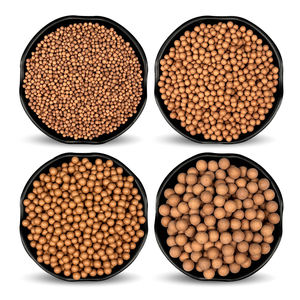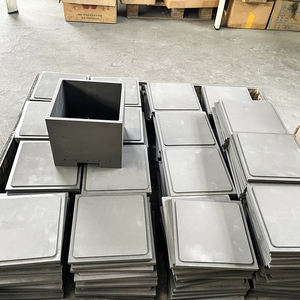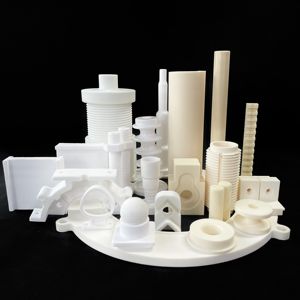Professional industry ceramic supplier, silicon nitride, silicon carbide, aluminum nitride and any other kinds of ceramics.
PRODUCT PARAMETERS
Description
Overview of High Temperature Resistance Refractory Porous Mullite Ceramics
High Temperature Resistance Refractory Porous Mullite Ceramics are non-metallic substances designed to withstand extreme temperatures exceeding 1,000°C, along with harsh chemical and physical stresses. They are essential for the inner linings of industrial furnaces, kilns, reactors, and incinerators, providing critical thermal insulation and structural integrity in processes ranging from metal and glass manufacturing to power generation.
Features of High Temperature Resistance Refractory Porous Mullite Ceramics
-
High-Temperature Resistance: Maintain structural strength and stability at temperatures often exceeding 1500°C.
-
Excellent Thermal Shock Resistance: Withstand rapid heating and cooling cycles without cracking or spalling.
-
Chemical Inertness: Resist corrosion and degradation from slags, molten metals, and acidic or basic environments.
-
High Mechanical Strength: Possess considerable load-bearing capacity at operating temperatures.
-
Low Thermal Conductivity: Provide effective insulation to improve energy efficiency and protect furnace structures.
-
Abrasion Resistance: Withstand erosion from solid materials and gas flows.
Specification of High Temperature Resistance Refractory Porous Mullite Ceramics
This material is high temperature resistant refractory porous mullite ceramics. It’s made mainly from mullite. This gives it excellent stability even at very high heat. The structure has many tiny holes inside. This is called porosity. The porosity level is controlled carefully. You can get different levels based on what you need.
The key feature is its ability to handle extreme heat. It works reliably long-term at temperatures over 1600°C. Short bursts of even higher heat are possible. This makes it perfect for very hot industrial jobs. The holes inside do more than reduce weight. They also trap heat really well. This insulation property is very strong. Heat doesn’t move through it easily.
Even with all these holes, the ceramic stays strong. It has good mechanical strength. It can handle physical stress and pressure well. This strength matters a lot in tough settings. It also handles sudden temperature changes without cracking. This is thermal shock resistance. Going from hot to cold quickly is no problem. It’s tough and durable over time.
You find this material in many demanding places. Furnace linings use it. Kiln furniture uses it. Thermal baffles use it. Heat treatment equipment uses it. It insulates pipes carrying hot gases. It filters hot liquids or gases. It supports catalyst materials. It works where other materials fail. The mix of high temperature strength, good insulation, and long life is key.
Applications of High Temperature Resistance Refractory Porous Mullite Ceramics
High temperature resistance refractory porous mullite ceramics handle extreme heat very well. They are strong and stable even above 1500°C. Their open porous structure allows gases or liquids to pass through. This combination makes them incredibly useful in tough industrial jobs.
A major job is filtering molten metal. The ceramics act as filters inside casting systems. They trap impurities like slag and oxides. Cleaner metal flows into molds. This makes stronger, higher quality castings. The ceramics survive the intense heat of the molten metal.
These ceramics are also top performers for thermal insulation. Their porous structure traps air. Air is a poor heat conductor. This blocks heat transfer effectively. You find them lining furnaces and kilns. They save significant energy. They protect outer furnace structures from damage.
They serve well as catalyst supports in chemical processes. The large surface area holds catalyst particles. Hot gases flow through the pores easily. Reactions happen efficiently. The material resists corrosion from harsh chemicals. It endures the high reaction temperatures.
Kiln furniture uses these ceramics too. They become shelves, setters, and posts. They hold items being fired inside kilns. They are lightweight. This reduces heat storage. They heat up and cool down fast. They last many cycles. They resist warping and cracking.
Hot gas filtration needs these ceramics. They clean exhaust gases from power plants or incinerators. They capture fine particles and ash. They operate directly in the hot gas stream. This avoids costly cooling steps. They handle thermal shock well.
Their stability and porosity are key. They manage heat and flow together. This solves problems in demanding high-heat settings. Industries rely on them for efficiency and product quality.
Company Profile
Tanki New Materials Co.Ltd. focus on the research and development, production and sales of ceramic products, serving the electronics, ceramics, chemical and other industries. Since its establishment in 2015, the company has been committed to providing customers with the best products and services, and has become a leader in the industry through continuous technological innovation and strict quality management.
Our products includes but not limited to Aerogel, Aluminum Nitride, Aluminum Oxide, Boron Carbide, Boron Nitride, Ceramic Crucible, Ceramic Fiber, Quartz Product, Refractory Material, Silicon Carbide, Silicon Nitride, ect. please feel free to contact us.

Payment Methods
T/T, Western Union, Paypal, Credit Card etc.
Shipment Methods
By air, by sea, by express, as customers request.
5 FAQs of High Temperature Resistance Refractory Porous Mullite Ceramics
Customers often ask about our high temperature resistant refractory porous mullite ceramics. Here are the top five questions and their answers.
What makes these ceramics special? These ceramics combine extreme heat resistance with controlled porosity. They are made mainly from mullite. Mullite handles very high temperatures well. The porous structure allows gases or liquids to pass through. This is vital for many industrial processes needing filtration or insulation under heat.
How hot can they handle? These porous mullite ceramics withstand temperatures over 1700 degrees Celsius. They maintain their structure and strength at these levels. This makes them suitable for severe thermal environments. Many metals or plastics would fail much earlier. They are built for furnace parts and kiln furniture.
Why is the porosity important? The tiny holes serve a key purpose. They let gases flow through the material. This is essential for filtering hot gases. It also helps with thermal insulation. The trapped air pockets slow heat transfer. You get filtration plus insulation in one material. This solves multiple problems in high-heat equipment.
Where are they used most? These ceramics are common in metal processing and glass making. They work well in furnace linings, burner nozzles, and thermal baffles. The porous structure is perfect for molten metal filters. They also serve in chemical processing units dealing with corrosive hot gases. Any place needing heat resistance plus gas flow uses them.
What are the main advantages? Their biggest strength is lasting under intense heat. They resist thermal shock better than dense ceramics. Sudden temperature changes cause less cracking. The porous nature offers built-in insulation. This saves energy. They also resist chemical attack from many slags and fumes. This combination boosts equipment lifespan and lowers replacement costs.
REQUEST A QUOTE
RELATED PRODUCTS

Low Ceramic Refractory Balls All Kinds of Ceramics High Security Ceramic Ball for Decoration and Filtering

Top Grade High Alumina Low Cement Castables Acid & Alkali Resistant Refractory Cement Custom Cutting Processing Service

High Alumina Low Cement Refractory Castables For Steel Mill Furnace Factory Direct Supply Monolithic Refractory Cutting

Sic Refractory Plates For Kilns

Customizable Bent Ceramic Parts Infrared Burner Gas Ceramic Grill Honeycomb Burning Plate Heating System Refractory Products



